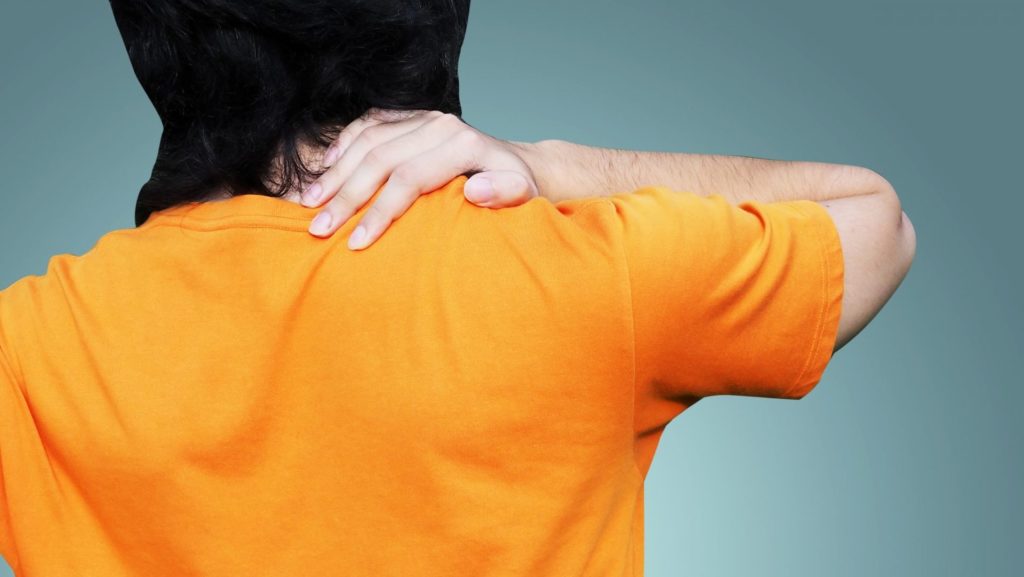CBD for Back and Neck Pain (Does it Work?)
80% of Americans have lower back pain at some time in their life. It can be caused by several things such as a sprain, muscle spasm, joint problems, spinal stenosis, arthritis or disc problems. Pain can also develop from an injury or as a result of aging.
Spinal Stenosis
Lumbar spinal canal stenosis is a narrowing of the space in the lower spine, which squeezes the nerves that branch down into the legs. This may cause back or leg pain, numbness, and weakness. The pain may increase with standing or walking. Spinal stenosis is due to aging and found most often in those over 50.
Degenerative Disc Disease
Discs are soft cushions with a gel center between the vertebral bones of the spine. With aging, they become flatter and less cushiony. If a disk weakens to the point that the cover around it tears, the inside portion may push through (herniate) and press on the nerve beside it. Herniated discs are most common in the lumbar or cervical spine, occurring in people in their 30s and 40s. When a disc presses on a lumbar or cervical nerve it can cause pain in the back, legs or arms. The extremities may become numb or tingly.
Neck Pain
Neck pain occurs in the occipital, cervical or upper back area, often the result of sprains or strains. Whiplash is a neck injury caused by an impact from the rear such as a motor vehicle accident. This may result in fracture, subluxation, joint instability, disc herniation or facet impingement. Arthritis, bone spurs, and spinal stenosis also cause neck pain.
Human Studies with CBD
NOTE FOR FIRST TIME READERS: Cannabinoids – such as THC, CBD – and terpenes are the main medically active components in cannabis (aka marijuana). For more information on these components and much more about the plant, see our section on the Science of Cannabis.
A 2005 study of the therapeutic role of medical cannabis for back pain due to degenerated discs found that: “64.7% of the patients stated the symptoms of their illness to have ‘much improved’ after cannabis ingestion, 29.4% stated to have ‘slightly improved’. 76.4% stated to be ‘very satisfied’ with their therapeutic use of cannabis.”
Cannabis is especially helpful for neuropathic pain and inflammation, which results by the pressure of a slipped disk upon a nerve. It can often reduce the amount of prescription opiates required, as it has a synergistic effect with pain medications. And it can help with the side effects of other FDA approved medications, such as nausea, dizziness or gastrointestinal upset.
There are multiple delivery systems for cannabis to treat back or neck pain, including topical cannabis, which is non-psychoactive and can be applied directly to the affected area. Many patients are prescribed a number of pills including muscle relaxant, opiate painkillers and NSAID anti-inflammatory medication. Cannabis can replace all of these as a single herbal medicine. Some patients take a daily dose one to three times per day as their ongoing anti-inflammatory treatment.
What CBD Options are Best for Pain Relief?
THC dominant products act best for pain relief, but both CBD and THC are anti-inflammatory and muscle relaxant. A CBD/THC hybrid or combination is a good place to start, since they act on different receptors. An internal dose of 10 mg up to 3x/day in an edible or tincture of a 1:1 mix is useful if you can tolerate some psychoactivity. If not, boost the CBD ratio up, even to 20:1. If you like THC, and need more pain relief, you can eliminate the CBD, perhaps choose an uplifting sativa strain to alleviate the depression that may accompany pain. Don’t forget to add a topical or CBD oil for local relief. You may have to reapply several times/day.
References
Bhattacharyya M. Back pain due to degenerated disc – Any therapeutic role of cannabis. Journal of Bone and Joint Surgery Br. 2008, 90-B no. SUPP II 22.
Silveira JW. Protective effects of cannabidiol on lesion-induced intervertebral disc degeneration. PLoS One. 2014, 9(12): e113161.
Yassin M, Garti A, Robinson D. Effect of medicinal cannabis therapy (MCT) on severity of chronic low back pain, sciatica and lumbar range of motion. International Journal of Anesthesiology and Pain Medicine. 2016, 2(1.5): 1-6.



